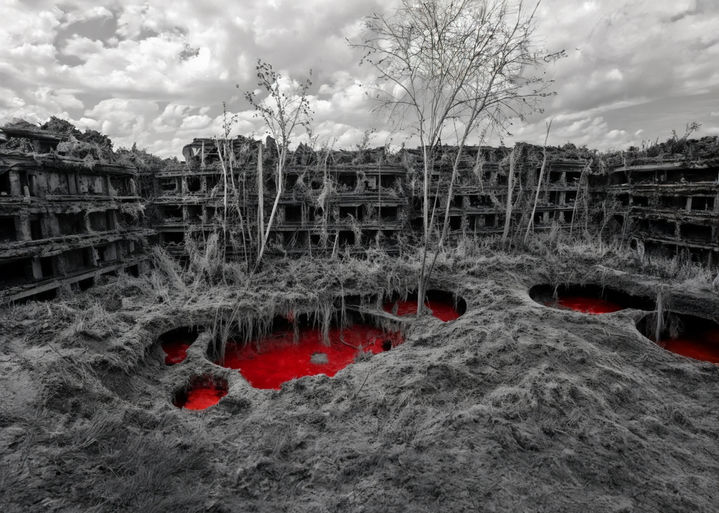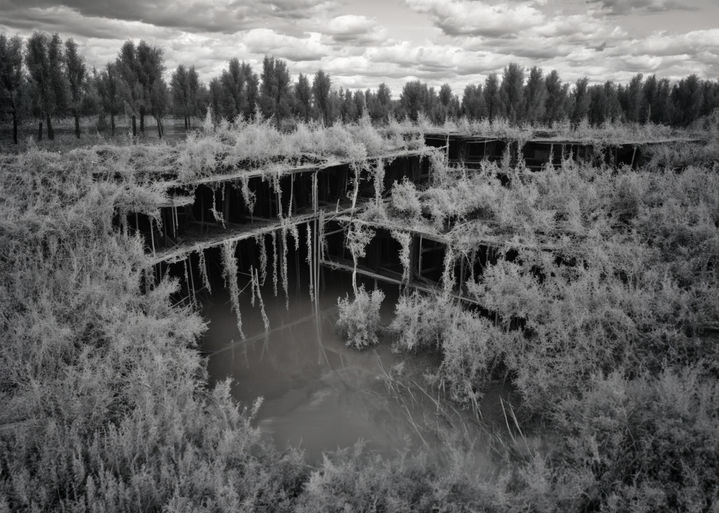
מַמְלֶכֶת אִיֵּי הַוַּדָּאוּת
במַמְלֶכֶת אִיֵּי הַוַּדָּאוּת, הכול בשפעה – פריחה והדר מתמזגים עם קץ, מוות והרקב. כמו "בממלכת עובדי האלילים הקמאית של ציפורים ויערות", כך גם הנופים המוצגים בסדרה זו נמתחים בין פאר אדיר לבין קריסה בלתי נמנעת, בין צמיחה פראית לבין שרידים חרוכים. הדימויים – שדות ביצות רוויים בבוץ, רכבים שהפכו לפסלים מעוותים של עצמם, שלוליות עכורות המדיפות תחושת דם קרוש או ברזל שהחליד – יוצרים עולם שבו זיכרון המלחמה הופך לחומר ביד היוצר, רווי חורבן אך גם יופי כמעט קדוש.
הסדרה "מַמְלֶכֶת אִיֵּי הַוַּדָּאוּת" מאזכרת את אמירתו של קלאוזביץ על טבעה הכאוטי של המלחמה אך גם מתכתבת עם מסע הילד-גיבור בספר "הציפור הצבועה" של יז'י קושינסקי. כמו הילד ההולך לאיבוד במרחבים האלימים והמנוכרים של ארץ לא מזוהה במזרח אירופה של מלחמת העולם השניה, כך הצופה מוצא את עצמו אבוד בתוך הנופים המושתקים של הסדרה. כל מבט נוסף חושף פרטים חדשים אך מותיר שאלות ללא מענה: האם מדובר בזירת קרב שנזנחה? במקום שלא היה קיים מעולם? או שמא בדימוי המנסה לספר סיפור על מה שקרה או על מה שעדיין קורה?
המלחמות הרבות שעיצבו את מזרח אירופה מטביעות את חותמן על העבודה, אך הן אינן מתפקדות כאן כהיסטוריה ברורה אלא כצללים וכתמים המחלחלים אל תוך הדימויים. האדום הקיטשי-במתכוון המשתלב בעבודות המונוכרומטיות, הצמחייה המתפרצת אל תוך שברי המבנים, וכלי הרכב המעוקמים יוצרים מראה שלא מתאר מלחמה אחת, אלא את מהות המלחמה עצמה.
הסדרה מעמידה אותנו בעמדת הילד התועה, גיבורו של קושינסקי, שמתבונן בעולם שאינו מסביר את עצמו, שאינו מציע נחמה או בהירות, אלא נותר זר ואכזרי. נופי הסדרה אינם עוסקים רק בזיכרון, אלא גם בבלבול – תחושה שדווקא מתוך אי-הוודאות הזו, מתגבשת אמת עמוקה יותר, בלתי ניתנת לתמלול.
Isles of Uncertainty
In the Isles of Uncertainty, everything is in abundance—growth and splendor converge with decay, death, and rot. Much like "the primal kingdom of bird and forest worshippers," the landscapes presented in this series stretch between majestic grandeur and inevitable collapse, between wild growth and charred remnants. The imagery—boggy fields saturated with mud, vehicles transformed into distorted sculptures of themselves, murky puddles exuding the essence of coagulated blood or rusted iron—constructs a world where the memory of war becomes malleable, a material shaped by the artist, imbued with both destruction and a nearly sacred beauty.
The series Isles of Uncertainty echoes Clausewitz’s statement about the chaotic nature of war while also engaging with the journey of the child protagonist in Jerzy Kosiński’s The Painted Bird. Like the child, wandering lost through the violent and alien landscapes of an unidentified Eastern European country during World War II, the viewer finds themselves adrift within the muted terrains of the series. Each additional glance reveals new details while leaving unanswered questions: is this an abandoned battlefield? A place that never existed? Or perhaps an image attempting to narrate a story of what was—or what still is?
The many wars that have shaped Eastern Europe leave their mark on the work, not as explicit historical references but as shadows and stains seeping into the imagery. The intentionally kitschy use of red interwoven with the monochromatic compositions, the vegetation overtaking fractured structures, and the contorted vehicles create a tableau that transcends any single war, instead embodying the very essence of war itself.
The series places us in the position of Kosiński’s wandering child, gazing upon a world that offers no explanations, no solace, no clarity—remaining perpetually strange and cruel. These landscapes do not merely address memory; they evoke disorientation—a sense that, out of this very uncertainty, a deeper, ineffable truth begins to coalesce.






























